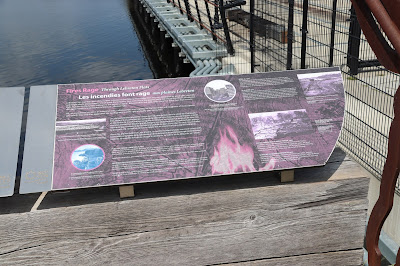Two plaques about rafting on the Ottawa River and fires in LeBreton Flats occupy a location on the south shore of the Ottawa River, north of the Ottawa River Pathway east of where Booth Street ends and Chaudière Crossing begins.
Rafting the Ottawa River
LeBreton Flats was a key stopping point and industrial centre for the raftsmen and timber rafts that travelled the river. The rafts were not as manoeuvrable as a conventional boat, and loggers had to navigate difficult waters as they floated the wood down to the industrial complex at LeBreton Flats.
Standing here at the edge of the river in the early 19th century, you would have seen giant rafts of squared timber coming down the Ottawa River.
Les trains de flottage sur la rivière des Outaouais
Les plaines LeBreton étaient un centre industriel important et un poste d'arrêt essential pour les flotteurs (ou encore « draveurs » ou « cageux », selon des expressons populaires) ainsi que leurs trains de bois flottants qui descendaient la rivière. Ces trains de flottage n'offraient pas la facilité de navigation des bateaux, et les bùcherons devaient navigeur dans des eaux difficiles en dirigeant le bois vers le bomplexe industriel des plaines LeBreton.
Si vous aviez été ici, au bord de la rivière au début du 19e siècle, vous auriez vu d'immenses radeaux de bois équarri descendre la rivière des Outaouais.
Fires Rage Through LeBreton Flats
LeBreton Flats was the heart of the lumber industry in the Ottawa River Valley. The area was dominated by wood piles, sawmills and freight sheds, and included a mix of wood-frame homes. Fires were one of the greatest perils not only to the citizens of Le Breton Flats, but also to the lumber industry in the nation's Capital. Between 1890 and 1903, there were five major fires that severely damaged industrial and residential areas in LeBreton Flats.
Yet, as a residential centre in an industrial zone, LeBreton Flats was a symbol of the heartiness and toughness of its occupants who rebuilt time and time again after the conflagrations of the 19th and early 20th centuries.
Les incendies font rage aux plaines LeBreton
Les plaines Le Breton étaient le centre de l'industrie du bois dans la vallée de l'Outaouais. Elles étaient donc envahies par quantité de piles de bois d'œuvre, de nombreuses scieries, et entrepôts de marchandises auxquels se mêlaient les maisons à ossature de bois. Les incendies étaient l'un des plus grands dangers, non seulement pour les habitants des plaines, mais aussi pour l'industrie du bois dans la capitale du pays. Entre 1890 et 1903, cinq incendies importants ont ravagé les secteurs industriels et résidentiels des plaines LeBreton.
Aussi, les plaines Le Breton, qui étaient un centre résidentiel dans une zone industrielle, furent-elles un symbole de la robustesse et de la résistance de ses habitants qui reconstruisirent maintes et maintes fois après chaque incendie du 19e siècle et du début du 20e siècle.
View of LeBreton Flats looking toward the Ottawa River, after the fire of April 26, 1900
Booth Family Collection, Library and Archives Canada, PA 121784
Vue des plaines LeBreton vers la rivière des Outaouais, après l'incendie du 26 avril 1900.
Collection de la famille Booth, Bibliothèque et Archives Canada, PA 121784



























